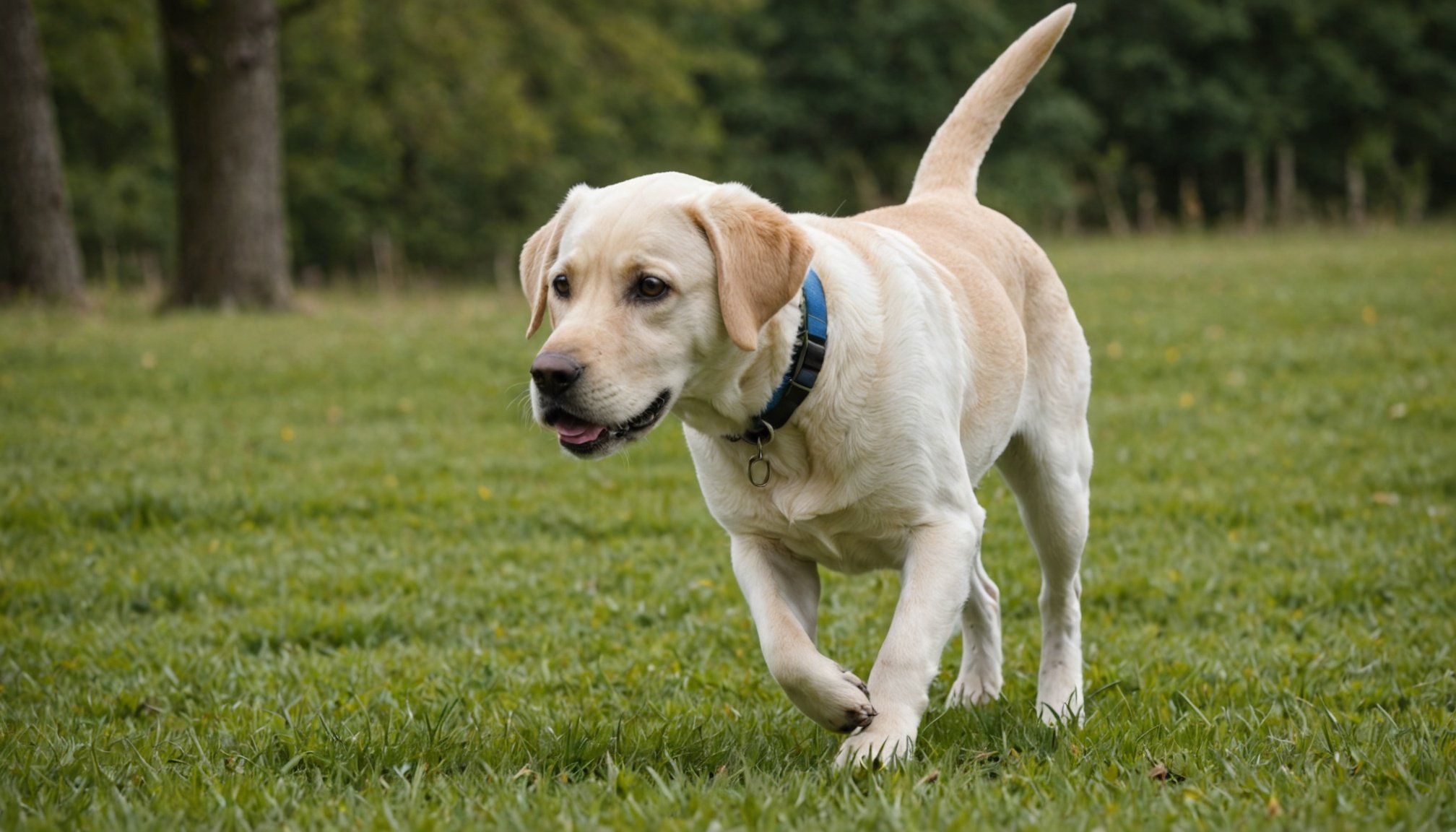Understanding Hip Dysplasia in Labradors
Hip dysplasia in Labrador retrievers is a prevalent concern, impacting their overall joint health. This condition occurs when the hip joint fails to develop properly, leading to joint instability and potential arthritis. For a clear understanding, consider it akin to a misaligned door hinge, which causes wear with every movement.
Grasping the implications of hip dysplasia, especially in young Labradors, is crucial for preventative care. These dogs, known for their energetic nature, are often affected during their growth phases. Early detection can significantly influence management and quality of life.
Also read : Ultimate guide to long-haired chihuahua grooming: prevent matting with these expert tips!
Genetic predisposition plays a significant role in the likelihood of a Labrador developing hip dysplasia. Although genetics are non-modifiable, awareness can guide breeding choices and mitigate risks. It’s important for breeders and owners alike to check for these genetic markers to protect the joint health of future generations.
Proper management, including controlled exercise and a healthy diet, can support Labradors prone to this condition. Vet consultations for potential treatment options are always advisable. A proactive approach can help maintain a happier, more mobile life for these beloved dogs.
In parallel : Expert techniques for boosting recall: top strategies for training your greyhound in open spaces
Early Signs of Hip Dysplasia
Identifying early indicators of hip dysplasia can be crucial for managing your pet’s health. Recognising symptoms early allows for timely intervention.
Behavioural Changes
One of the early indicators of hip dysplasia is noticeable behavioural changes. Pets may show reluctance to exercise, or have a reduced activity level. Common signs include difficulty in rising, jumping, or showing discomfort when lying down. These behaviours can signal underlying joint issues.
Physical Symptoms
Physically, hip dysplasia can manifest as limping or changes in gait, reflecting difficulty in movement. Pay attention to any asymmetry in hind limb movement, as well as visible discomfort when your pet is touched or handled. Such symptoms are indicative of joint issues that require veterinary attention.
Impacts on Daily Life
The impacts on daily life are significant for pets with hip dysplasia. You might observe challenges during normal play, or in interactions due to discomfort. Behavioural changes often reflect pain or distress, becoming evident during walks or exercise sessions. Monitoring these daily interactions can provide further insight into the early indicators and symptoms of hip dysplasia.
Risk Factors Specific to Young Labradors
While Labrador retrievers are known for their friendly and energetic nature, certain Labrador traits pose unique risk factors. These dogs have a genetic predisposition to certain health issues. Genetics often play a role in common breed tendencies, contributing to ailments like hip dysplasia and elbow dysplasia. Labrador retrievers are especially susceptible due to their body structure and inheritance from their lineage.
Another significant consideration is their rapid growth. Young Labradors experience swift physical development, leading to increased weight gain. This rapid growth rate can place undue stress on their joints, exacerbating potential health risks. Hip dysplasia, particularly, can be influenced by how quickly a Labrador gains weight during its formative months.
Furthermore, environmental factors contribute to joint stress in Labradors. Slippery floors or excessive jumping can escalate joint issues and injuries. Engaging in high-impact activities can strain their developing bones and joints, especially when not balanced with proper nutrition and controlled exercise. Owners should be wary of these factors, ensuring environments are suitable for their physical well-being. Providing a conscious blend of activity, diet, and joint protection can mitigate these concerns, safeguarding their Labrador’s health.
Age-Related Considerations
Understanding a Labrador’s development requires attention to various age factors, especially during critical growth phases. These development stages are pivotal for health and behaviour, with young dogs undergoing significant physical changes. Recognising these stages aids in ensuring a balanced and healthy upbringing.
Critical Growth Phases
Developmental stages in Labradors, such as infancy and adolescence, are marked by rapid growth that may influence joint stability. Monitoring these periods is essential, as joint health can significantly impact mobility. Engaging in regular veterinary check-ups can preemptively identify and address potential issues, ensuring robust development.
Age Range for Observing Symptoms
The onset of symptoms related to health or behavioural concerns can appear at various ages in Labradors. It is common for early signs to manifest between 6 months and 2 years, coinciding with their growth spurts. Vigilance during the first year is crucial, as it is when most developmental challenges arise. Differences in how symptoms appear depending on their age emphasise the need for careful observation. As Labradors mature, these manifestations may evolve, requiring ongoing attention from owners to maintain their well-being. Building familiarisation with common traits at each stage aids in identifying anomalies sooner.
Actionable Steps for Early Detection
Early detection methods are crucial in maintaining pet health. Engaging in regular check-ups and screenings with a veterinarian is the first step. These visits allow for professional monitoring and identification of potential health issues before they become serious. Veterinarians utilise advanced tools and expertise to ensure your pet’s well-being.
For owners, self-assessment techniques can supplement professional care. Monitor your pet’s behaviour and physical condition closely. Notice any sudden changes? Consider these as red flags and consult your vet. Keeping a journal is a practical way to track these changes. Note shifting habits, appetite, weight, or any irregular activity. Regular monitoring aids both in catching anomalies early and in facilitating discussions with your vet.
Preventive care is another pillar of early detection. Vaccinations, a balanced diet, and exercise are essential components to stave off potential health issues. Prevention not only promotes a longer, healthier life for your pet but also reduces the likelihood of unexpected health complications. Follow these steps and remain attentive to any shifts in your pet’s condition. Embrace both professional advice and hands-on monitoring to ensure comprehensive preventive care. Remember, being proactive can make a significant difference in your pet’s health journey.
Veterinary Advice and Treatment Options
Understanding and addressing hip dysplasia necessitates a comprehensive veterinary consultation. This ensures that treatment options are tailored to each individual case.
Recommended Veterinary Practices
A personalised assessment is paramount. Each veterinary consultation should start with a detailed examination and diagnosis. This allows for a customised action plan, vital in managing hip dysplasia. Discuss potential interventions and explore the feasibility of different treatments with a veterinarian.
Regular imaging, such as X-rays, is crucial for monitoring any changes in the condition. This helps to track the progression and effectiveness of chosen treatment options.
Treatment and Management Approaches
Hip dysplasia care includes various medical, surgical, and therapeutic treatment options. Medications might be prescribed to manage pain and inflammation. Surgical options, though more invasive, could significantly improve a pet’s quality of life in severe cases.
Nutritional support and weight management play essential roles in reducing joint stress. Maintaining an optimal weight can alleviate excess pressure on the hips, aiding in long-term care. Incorporate a balanced diet and controlled feeding to manage this effectively.
Rehabilitation exercises, tailored to promote joint health, can further enhance recovery. These exercises should be introduced gradually, with guidance from a qualified therapist or veterinarian.
Conclusion: Empowering Labrador Owners
Owning a Labrador comes with a wealth of joy and satisfaction, but it also requires responsible ownership. A pivotal aspect of this responsibility is educating oneself about the needs of these lively companions. Understanding dietary demands, exercise needs, and behavioural traits is a cornerstone of proper pet care.
Equally crucial is the adoption of proactive measures in managing your Labrador’s health. Regular veterinary check-ups, vaccinations, and preventive treatments against common ailments solidify your dog’s well-being. For instance, keeping up with routine parasite treatments can prevent unexpected health issues, saving both time and potential costs.
Additionally, fostering connections with fellow Labrador enthusiasts can be incredibly beneficial. By establishing a support network, you gain a platform for sharing experiences, advice, and solutions that strengthen your understanding of Labrador care. Whether it’s through local meet-ups or online communities, such connections provide invaluable insights.
Adopting this multifaceted approach enriches your journey with your Labrador. It encourages responsible decisions, supports proactive health management, and community engagement. In turn, this empowers you to offer the best care, ensuring a happy and fulfilling life for your furry friend.










